Aboveground Biomass Dynamics of a Coastal Wetland Ecosystem Driven by Land Use/Land Cover Transformation
Abstract
:1. Introduction
2. Materials and Methods
2.1. Study Area
2.2. Data
2.2.1. Vegetation Index Data
2.2.2. Meteorological Data
2.2.3. LULC Data
2.2.4. Observation Data
2.3. Method
2.3.1. Overview of BEPS
2.3.2. Mapping the Driving Processes
2.3.3. Indicators of Evaluation
2.3.4. Spatiotemporal Dynamic Analysis
3. Results and Discussion
3.1. Change Results and Evolutionary Processes of LULC during 2000–2015
3.1.1. Changes in LULC in Study Area
3.1.2. Cumulative Transformation between LULC Types
3.2. AGB Simulation Results Validation and Change Analysis
3.2.1. Validation of the AGB Calculation
3.2.2. AGB Change under the Influence of the Driving Process
3.3. Analysis of the Influence Process of LULC Changes on AGB
3.3.1. The Total Change in AGB Associated with the Driving Processes
3.3.2. Change of AGB in Multiple and Single Driving Processes
3.3.3. Changes in AGB under Human-Induced, Natural, and Human-Natural Coupling Driving Processes
4. Conclusions
Author Contributions
Funding
Data Availability Statement
Acknowledgments
Conflicts of Interest
References
- Lhakpa, D.; Fan, Y.; Cai, Y. Continuous Karakoram Glacier Anomaly and Its Response to Climate Change during 2000–2021. Remote Sens. 2022, 14, 6281. [Google Scholar] [CrossRef]
- Briere, M.D.; Gajewski, K. Holocene human-environment interactions across the Northern American prairie-forest ecotone. Anthropocene 2023, 41, 100367. [Google Scholar] [CrossRef]
- Chemeda, B.A.; Wakjira, F.S.; Hizikias, E.B. Tree diversity and biomass carbon stock analysis along altitudinal gradients in coffee-based agroforestry system of Western Ethiopia. Cogent Food Agric. 2022, 8, 2123767. [Google Scholar] [CrossRef]
- Sadai, S.; Spector, R.A.; DeConto, R.; Gomez, N. The Paris Agreement and Climate Justice: Inequitable Impacts of Sea Level Rise Associated With Temperature Targets. Earth’s Future 2022, 10, e2022EF002940. [Google Scholar] [CrossRef]
- Zhao, X.; Ma, X.; Chen, B.; Shang, Y.; Song, M. Challenges toward carbon neutrality in China: Strategies and countermeasures. Resour. Conserv. Recycl. 2022, 176, 105959. [Google Scholar] [CrossRef]
- Wang, Y.; Guo, C.-h.; Chen, X.-j.; Jia, L.-q.; Guo, X.-n.; Chen, R.-s.; Zhang, M.-s.; Chen, Z.-y.; Wang, H.-d. Carbon peak and carbon neutrality in China: Goals, implementation path and prospects. China Geol. 2021, 4, 720–746. [Google Scholar] [CrossRef]
- Rindfuss, R.R.; Entwisle, B.; Walsh, S.J.; An, L.; Badenoch, N.; Brown, D.G.; Deadman, P.; Evans, T.P.; Fox, J.; Geoghegan, J.; et al. Land use change: Complexity and comparisons. J. Land Use Sci. 2008, 3, 1–10. [Google Scholar] [CrossRef] [Green Version]
- Mallinis, G.; Koutsias, N.; Arianoutsou, M. Monitoring land use/land cover transformations from 1945 to 2007 in two peri-urban mountainous areas of Athens metropolitan area, Greece. Sci. Total Environ. 2014, 490, 262–278. [Google Scholar] [CrossRef]
- Ren, G.; Zhao, Y.; Wang, J.; Wu, P.; Ma, Y. Ecological effects analysis of Spartina alterniflora invasion within Yellow River delta using long time series remote sensing imagery. Estuar. Coast. Shelf Sci. 2020, 249, 107111. [Google Scholar] [CrossRef]
- Ouyang, Z.; Wang, X.; Miao, H. A primary study on Chinese terrestrial ecosystem services and their ecological-economic values. Acta Ecol. Sin. 1999, 19, 607–613. [Google Scholar]
- Duarte, C.M.; Losada, I.J.; Hendriks, I.E.; Mazarrasa, I.; Mazarrasa, N.M. Correction: Corrigendum: The role of coastal plant communities for climate change mitigation and adaptation. Nat. Clim. Chang. 2016, 6, 802. [Google Scholar] [CrossRef]
- Wang, F.; Sanders, C.J.; Santos, I.R.; Tang, J.; Schuerch, M.; Kirwan, M.L.; Kopp, R.E.; Zhu, K.; Li, X.; Yuan, J.; et al. Global blue carbon accumulation in tidal wetlands increases with climate change. Natl. Sci. Rev. 2020, 8, nwaa296. [Google Scholar] [CrossRef] [PubMed]
- Chastain, S.G.; Kohfeld, K.E.; Pellatt, M.G.; Olid, C.; Gailis, M. Quantification of blue carbon in salt marshes of the Pacific coast of Canada. Biogeosciences 2022, 19, 5751–5777. [Google Scholar] [CrossRef]
- Mcleod, E.; Chmura, G.L.; Bouillon, S.; Salm, R.; Björk, M.; Duarte, C.M.; Lovelock, C.E.; Schlesinger, W.H.; Silliman, B.R. A blueprint for blue carbon: Toward an improved understanding of the role of vegetated coastal habitats in sequestering CO2. Front. Ecol. Environ. 2011, 9, 552–560. [Google Scholar] [CrossRef] [Green Version]
- Sun, S.; Wang, Y.; Song, Z.; Chen, C.; Zhang, Y.; Chen, X.; Chen, W.; Yuan, W.; Wu, X.; Ran, X.; et al. Modelling Aboveground Biomass Carbon Stock of the Bohai Rim Coastal Wetlands by Integrating Remote Sensing, Terrain, and Climate Data. Remote Sens. 2021, 13, 4321. [Google Scholar] [CrossRef]
- Macreadie, P.I.; Nielsen, D.A.; Kelleway, J.J.; Atwood, T.B.; Seymour, J.R.; Petrou, K.; Connolly, R.M.; Thomson, A.C.; Trevathan-Tackett, S.M.; Ralph, P.J. Can we manage coastal ecosystems to sequester more blue carbon? Front. Ecol. Environ. 2017, 15, 206–213. [Google Scholar] [CrossRef] [Green Version]
- Chu, X.; Han, G.; Xing, Q.; Xia, J.; Sun, B.; Li, X.; Yu, J.; Li, D.; Song, W. Changes in plant biomass induced by soil moisture variability drive interannual variation in the net ecosystem CO2 exchange over a reclaimed coastal wetland. Agric. For. Meteorol. 2019, 264, 138–148. [Google Scholar] [CrossRef]
- Zekarias, T.; Govindu, V.; Kebede, Y.; Gelaw, A. Geospatial Analysis of Wetland Dynamics on Lake Abaya-Chamo, The Main Rift Valley of Ethiopia. Heliyon 2021, 7, e07943. [Google Scholar] [CrossRef]
- Aitali, R.; Snoussi, M.; Kolker, A.S.; Oujidi, B.; Mhammdi, N. Effects of Land Use/Land Cover Changes on Carbon Storage in North African Coastal Wetlands. J. Mar. Sci. Eng. 2022, 10, 364. [Google Scholar] [CrossRef]
- Minta, M.; Kibret, K.; Thorne, P.; Nigussie, T.; Nigatu, L. Land use and land cover dynamics in Dendi-Jeldu hilly-mountainous areas in the central Ethiopian highlands. Geoderma 2018, 314, 27–36. [Google Scholar] [CrossRef]
- Massetti, A.; Gil, A. Mapping and assessing land cover/land use and aboveground carbon stocks rapid changes in small oceanic islands’ terrestrial ecosystems: A case study of Madeira Island, Portugal (2009–2011). Remote Sens. Environ. 2020, 239, 111625. [Google Scholar] [CrossRef]
- Acheampong, J.O.; Attua, E.M.; Mensah, M.; Fosu-Mensah, B.Y.; Apambilla, R.A.; Doe, E.K. Livelihood, carbon and spatiotemporal land-use land-cover change in the Yenku forest reserve of Ghana, 2000–2020. Int. J. Appl. Earth Obs. Geoinf. 2022, 112, 102938. [Google Scholar] [CrossRef]
- Li, Y.; Qiu, J.; Li, Z.; Li, Y. Assessment of Blue Carbon Storage Loss in Coastal Wetlands under Rapid Reclamation. Sustainability 2018, 10, 2818. [Google Scholar] [CrossRef] [Green Version]
- Liu, J.; Chen, J.M.; Cihlar, J.; Park, W.M. A process-based boreal ecosystem productivity simulator using remote sensing inputs. Remote Sens. Environ. 1997, 62, 158–175. [Google Scholar] [CrossRef]
- Liu, J.; Chen, J.M.; Cihlar, J.; Chen, W. Net primary productivity distribution in the BOREAS region from a process model using satellite and surface data. J. Geophys. Res. Atmos. 1999, 104, 27735–27754. [Google Scholar] [CrossRef]
- Tian, H.; Liu, M.; Zhang, C.; Ren, W.; Xu, X.; Chen, G.; Lu, C.; Tao, B. The Dynamic Land Ecosystem Model (DLEM) for Simulating Terrestrial Processes and Interactions in the Context of Multifactor Global Change. Acta Geogr. Sin. 2010, 65, 1027–1047. [Google Scholar] [CrossRef]
- Feng, X.; Liu, G.; Chen, J.M.; Chen, M.; Liu, J.; Ju, W.M.; Sun, R.; Zhou, W. Net primary productivity of China’s terrestrial ecosystems from a process model driven by remote sensing. J. Environ. Manag. 2007, 85, 563–573. [Google Scholar] [CrossRef]
- Ma, T.; Li, X.; Bai, J.; Ding, S.; Zhou, F.; Cui, B. Four decades’ dynamics of coastal blue carbon storage driven by land use/land cover transformation under natural and anthropogenic processes in the Yellow River Delta, China. Sci. Total Environ. 2019, 655, 741–750. [Google Scholar] [CrossRef]
- Yu, J.; Wang, Y.; Li, Y.; Dong, H.; Zhou, D.; Han, G.; Wu, H.; Wang, G.; Mao, P.; Gao, Y. Soil organic carbon storage changes in coastal wetlands of the modern Yellow River Delta from 2000 to 2009. Biogeosciences 2012, 9, 2325–2331. [Google Scholar] [CrossRef] [Green Version]
- Zhao, H.; Lin, Y.; Delang, C.O.; Ma, Y.; Zhou, J.; He, H. Contribution of soil erosion to the evolution of the plateau-plain-delta system in the Yellow River basin over the past 10,000 years. Palaeogeogr. Palaeoclimatol. Palaeoecol. 2022, 601, 111133. [Google Scholar] [CrossRef]
- Chen, C.; Ma, Y.; Ren, G.; Wang, J. Aboveground biomass of salt-marsh vegetation in coastal wetlands: Sample expansion of in situ hyperspectral and Sentinel-2 data using a generative adversarial network. Remote Sens. Environ. 2022, 270, 112885. [Google Scholar] [CrossRef]
- Raich, J.W.; Rastetter, E.B.; Melillo, J.M.; Kicklighter, D.W.; Steudler, P.A.; Peterson, B.J.; Grace, A.L.; Moore, B., III; Vorosmarty, C.J. Potential Net Primary Productivity in South America: Application of a Global Model. Ecol. Appl. 1991, 1, 399–429. [Google Scholar] [CrossRef] [Green Version]
- Running, S.W.; Coughlan, J.C. A general model of forest ecosystem processes for regional applications I. Hydrologic balance, canopy gas exchange and primary production processes. Ecol. Model. 1988, 42, 125–154. [Google Scholar] [CrossRef]
- Farquhar, G.D.; von Caemmerer, S.; Berry, J.A. A biochemical model of photosynthetic CO2 assimilation in leaves of C3 species. Planta 1980, 149, 78–90. [Google Scholar] [CrossRef] [Green Version]
- Qiang, Y.; Wang, T.-D. Simulation of the Physiological Responses of C3 Plant Leaves to Environmental Factors by a Model Which Combines Stomatal Conductance, Photosynthesis and Transpiration. J. Integr. Plant Biol. 1998, 40, 740–750. [Google Scholar]
- Nanzad, L.; Zhang, J.; Tuvdendorj, B.; Yang, S.; Rinzin, S.; Prodhan, F.A.; Sharma, T.P.P. Assessment of Drought Impact on Net Primary Productivity in the Terrestrial Ecosystems of Mongolia from 2003 to 2018. Remote Sens. 2021, 13, 2522. [Google Scholar] [CrossRef]
- Chen, J.M.; Liu, J.; Cihlar, J.; Goulden, M.L. Daily canopy photosynthesis model through temporal and spatial scaling for remote sensing applications. Ecol. Model. 1999, 124, 99–119. [Google Scholar] [CrossRef] [Green Version]
- Zhang, S.; Zhang, J.; Bai, Y.; Koju, U.A.; Igbawua, T.; Chang, Q.; Zhang, D.; Yao, F. Evaluation and improvement of the daily boreal ecosystem productivity simulator in simulating gross primary productivity at 41 flux sites across Europe. Ecol. Model. 2018, 368, 205–232. [Google Scholar] [CrossRef]
- Liu, J.; Chen, J.M.; Cihlar, J. Mapping evapotranspiration based on remote sensing: An application to Canada’s landmass. Water Resour. Res. 2003, 39, 1189. [Google Scholar] [CrossRef]
- Liu, J.; Chen, J.M.; Cihlar, J.; Chen, W. Net primary productivity mapped for Canada at 1-km resolution. Glob. Ecol. Biogeogr. 2002, 11, 115–129. [Google Scholar] [CrossRef] [Green Version]
- Kim, W. Flood-built land. Nat. Geosci. 2012, 5, 521–522. [Google Scholar] [CrossRef]
- Kirwan, M.L.; Megonigal, J.P. Tidal wetland stability in the face of human impacts and sea-level rise. Nature 2013, 504, 53–60. [Google Scholar] [CrossRef] [PubMed]
- Han, M.; Pan, B.; Liu, Y.B.; Yu, H.Z.; Liu, Y.R. Wetland biomass inversion and space differentiation: A case study of the Yellow River Delta Nature Reserve. PLoS ONE 2019, 14, e0210774. [Google Scholar] [CrossRef] [Green Version]
- Chen, M.; Ke, Y.; Bai, J.; Li, P.; Lyu, M.; Gong, Z.; Zhou, D. Monitoring early stage invasion of exotic Spartina alterniflora using deep-learning super-resolution techniques based on multisource high-resolution satellite imagery: A case study in the Yellow River Delta, China. Int. J. Appl. Earth Obs. Geoinf. 2020, 92, 102180. [Google Scholar] [CrossRef]
- Liu, L.; Han, M.; Liu, Y.B.; Pan, B. Spatial distribution of wetland vegetation biomass and its influencing factors in the Yellow River Delta nature reserve. Shengtai Xuebao/Acta Ecol. Sin. 2017, 37, 4346–4355. [Google Scholar]
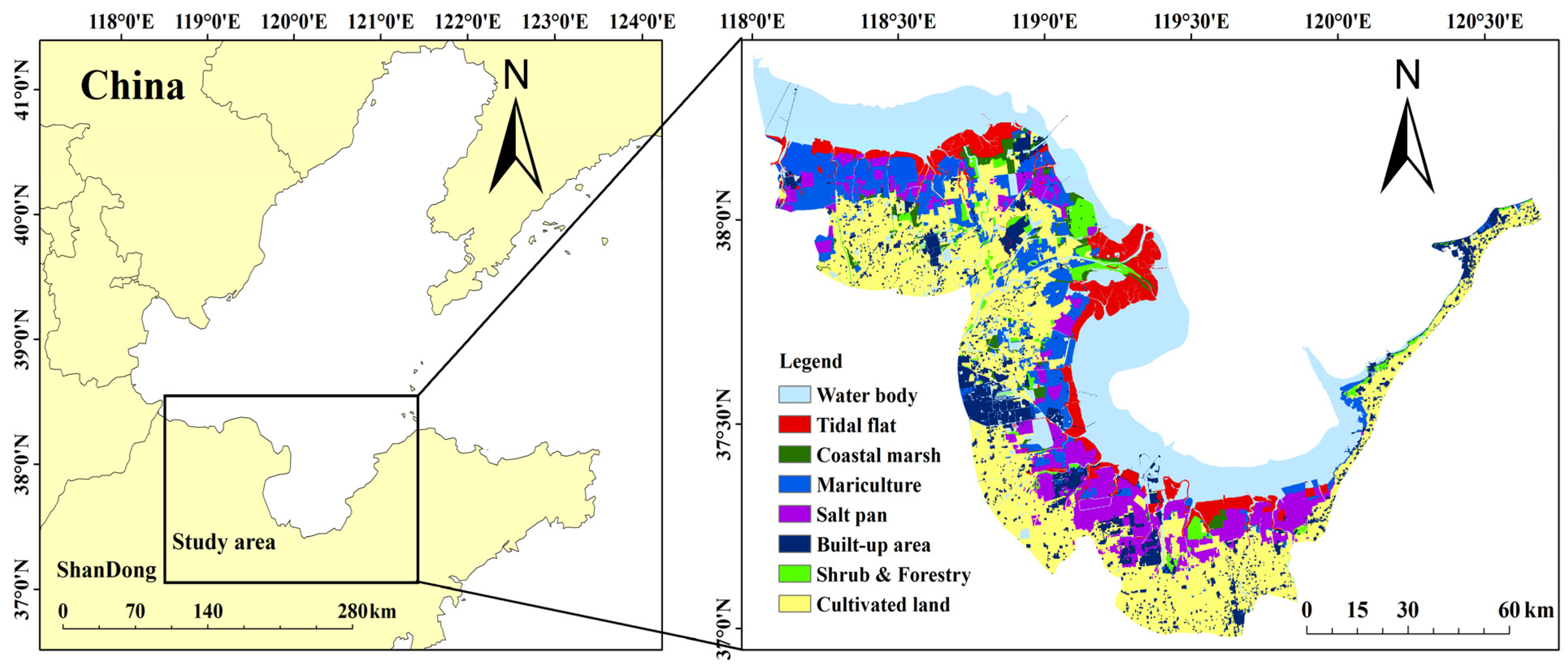
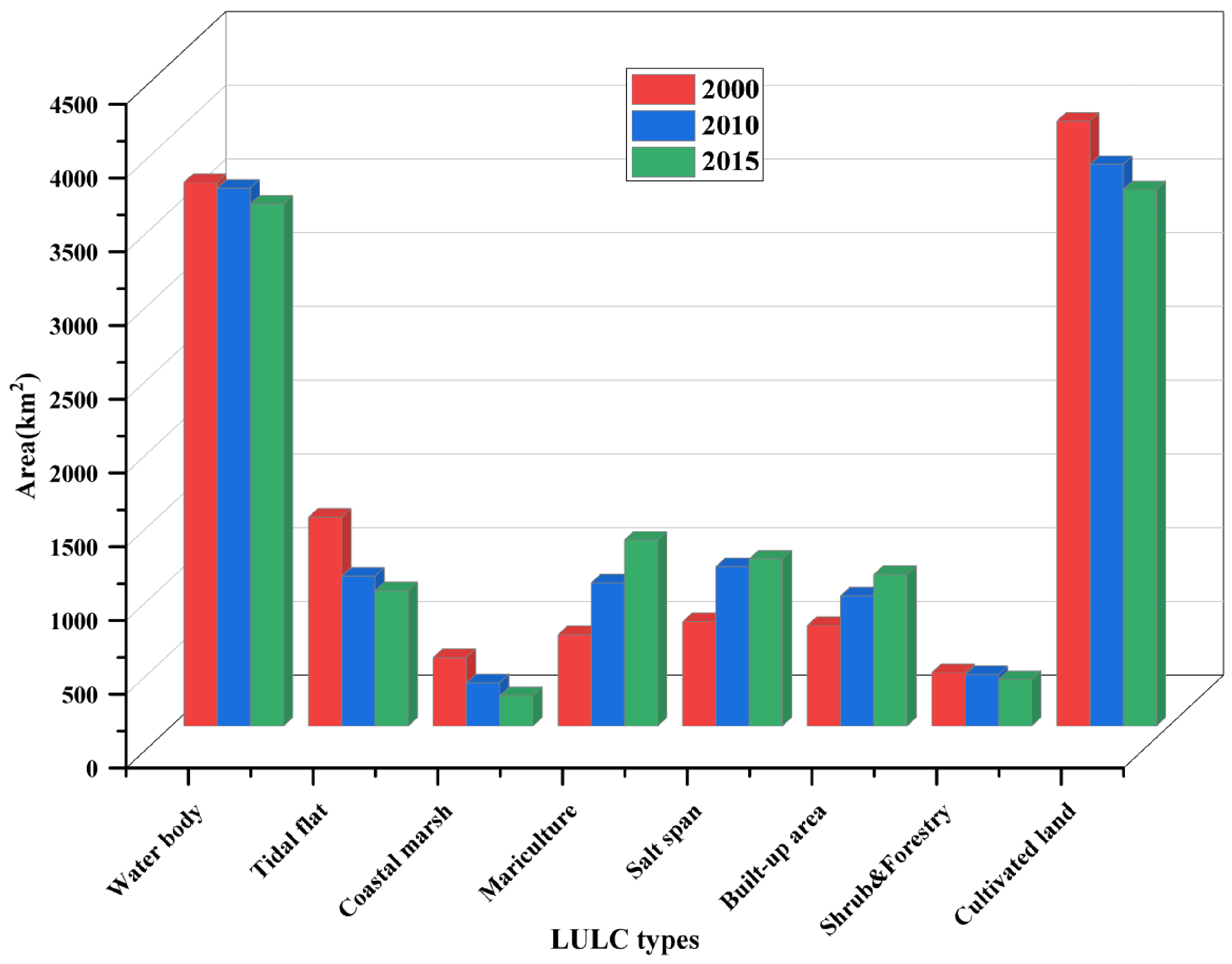
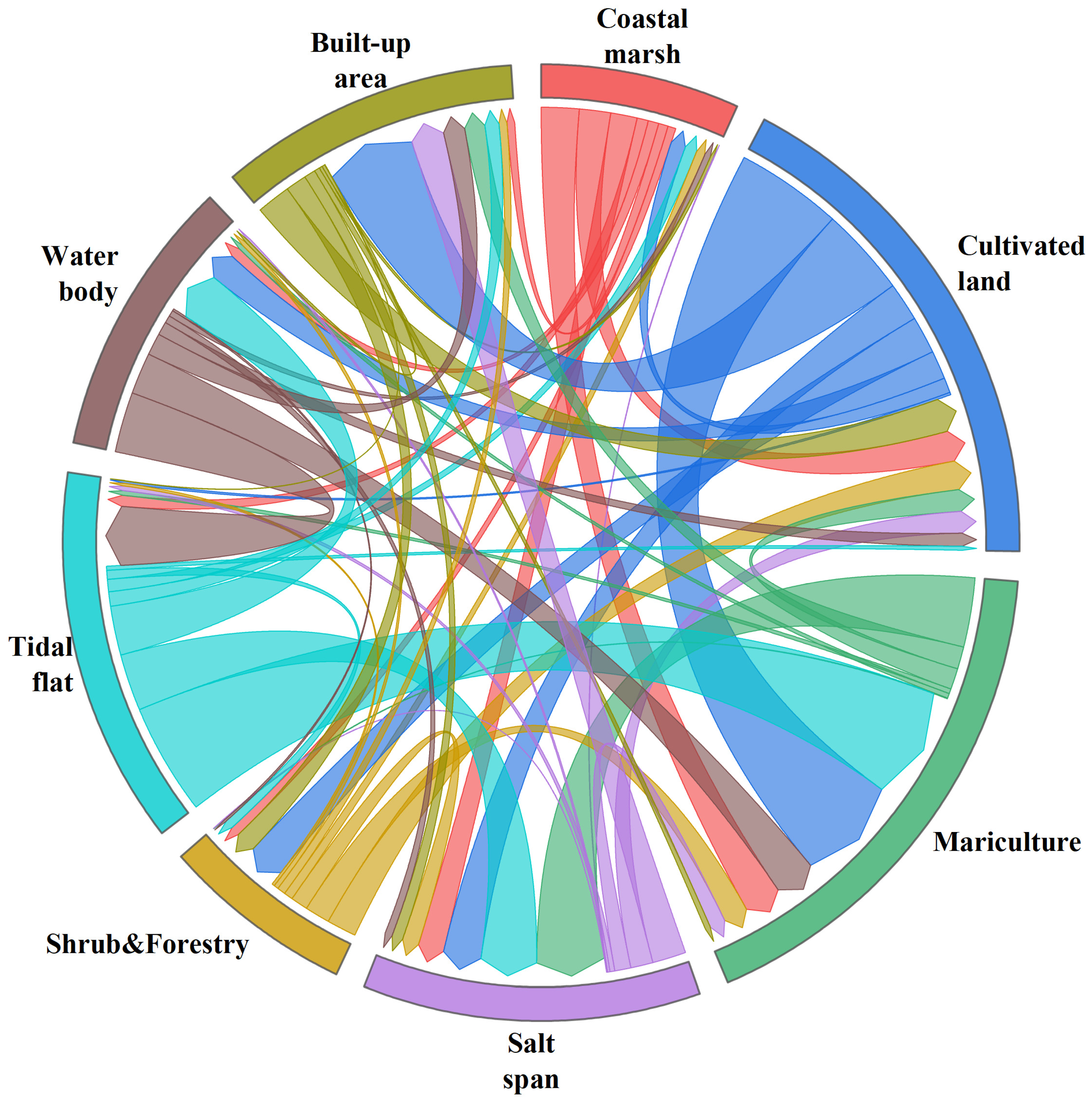
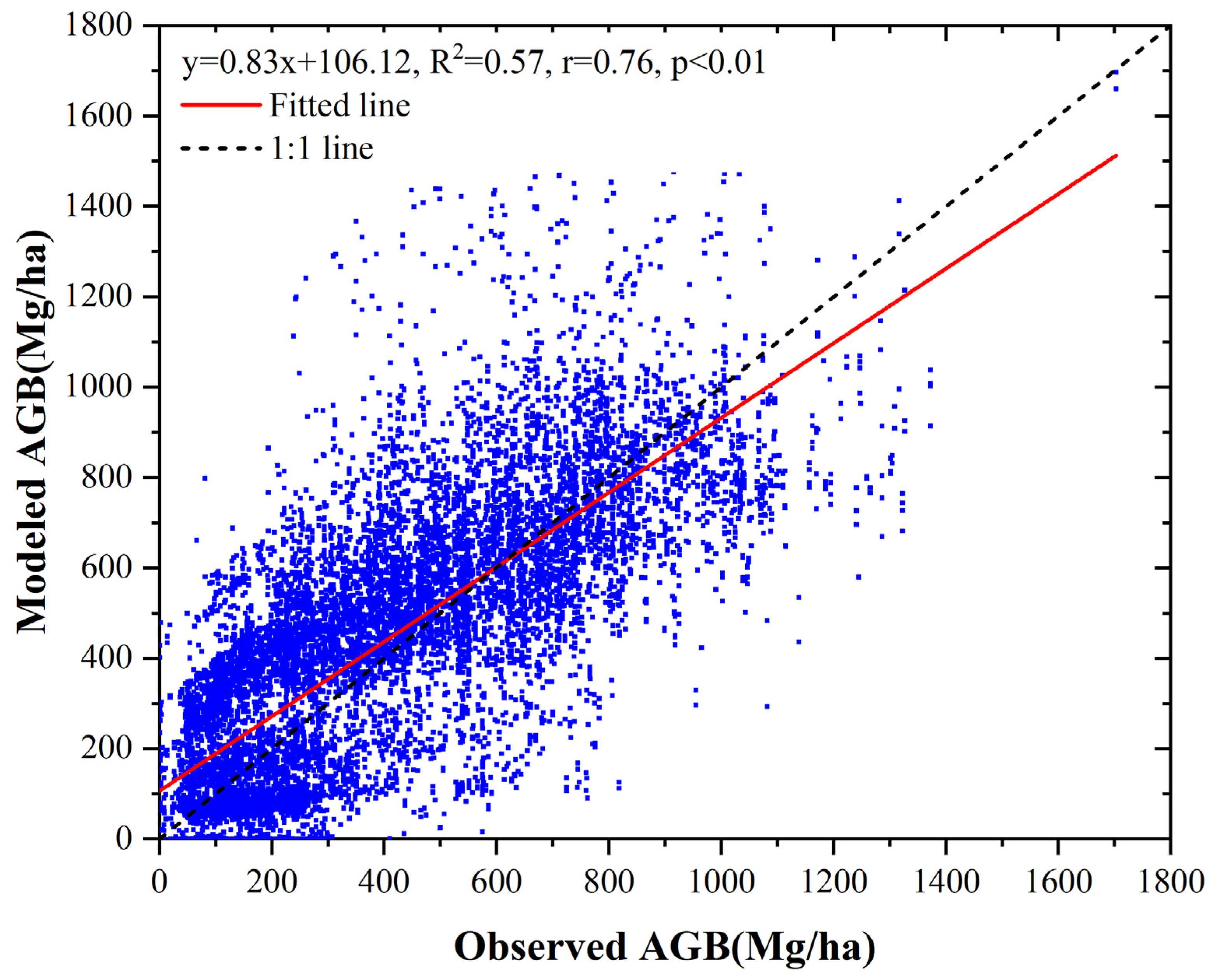
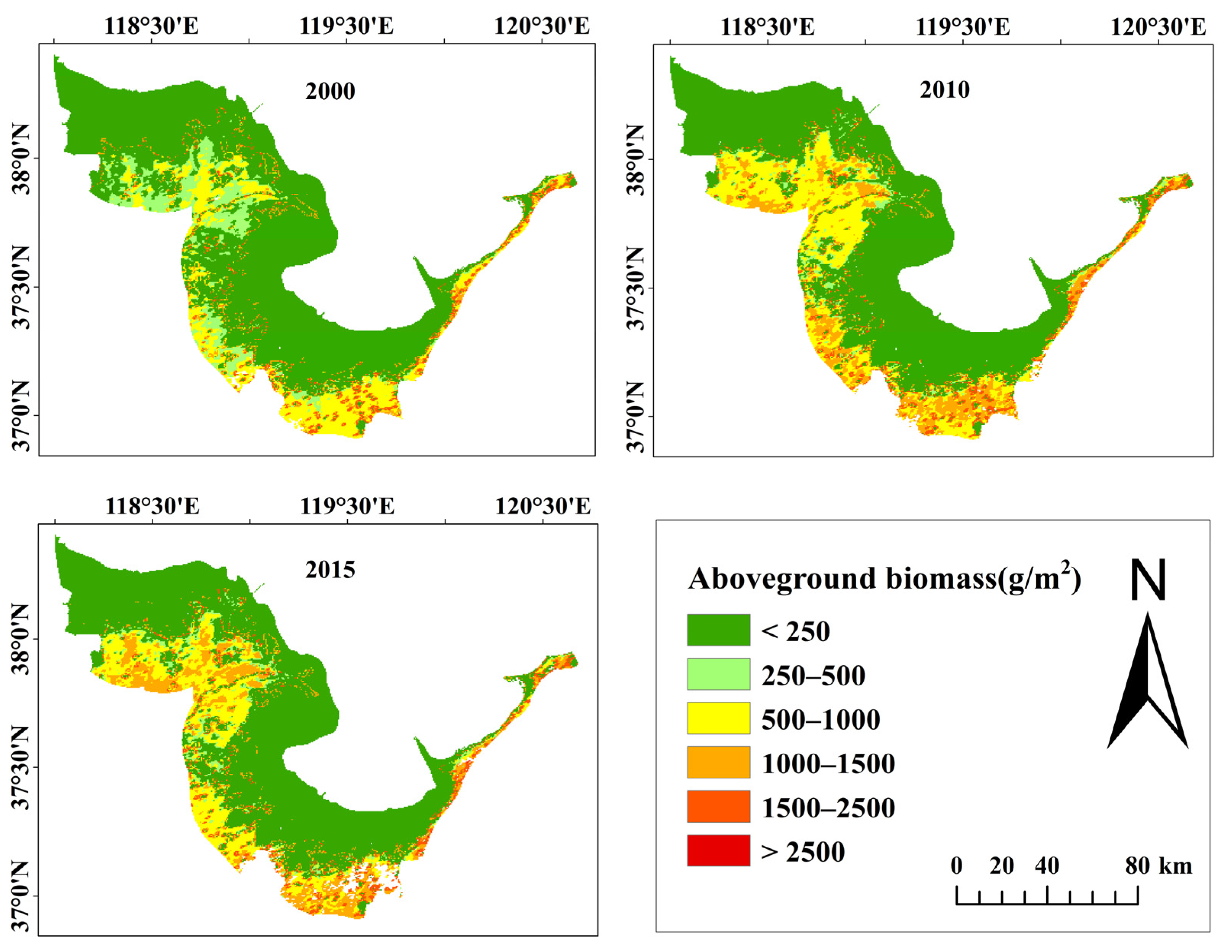

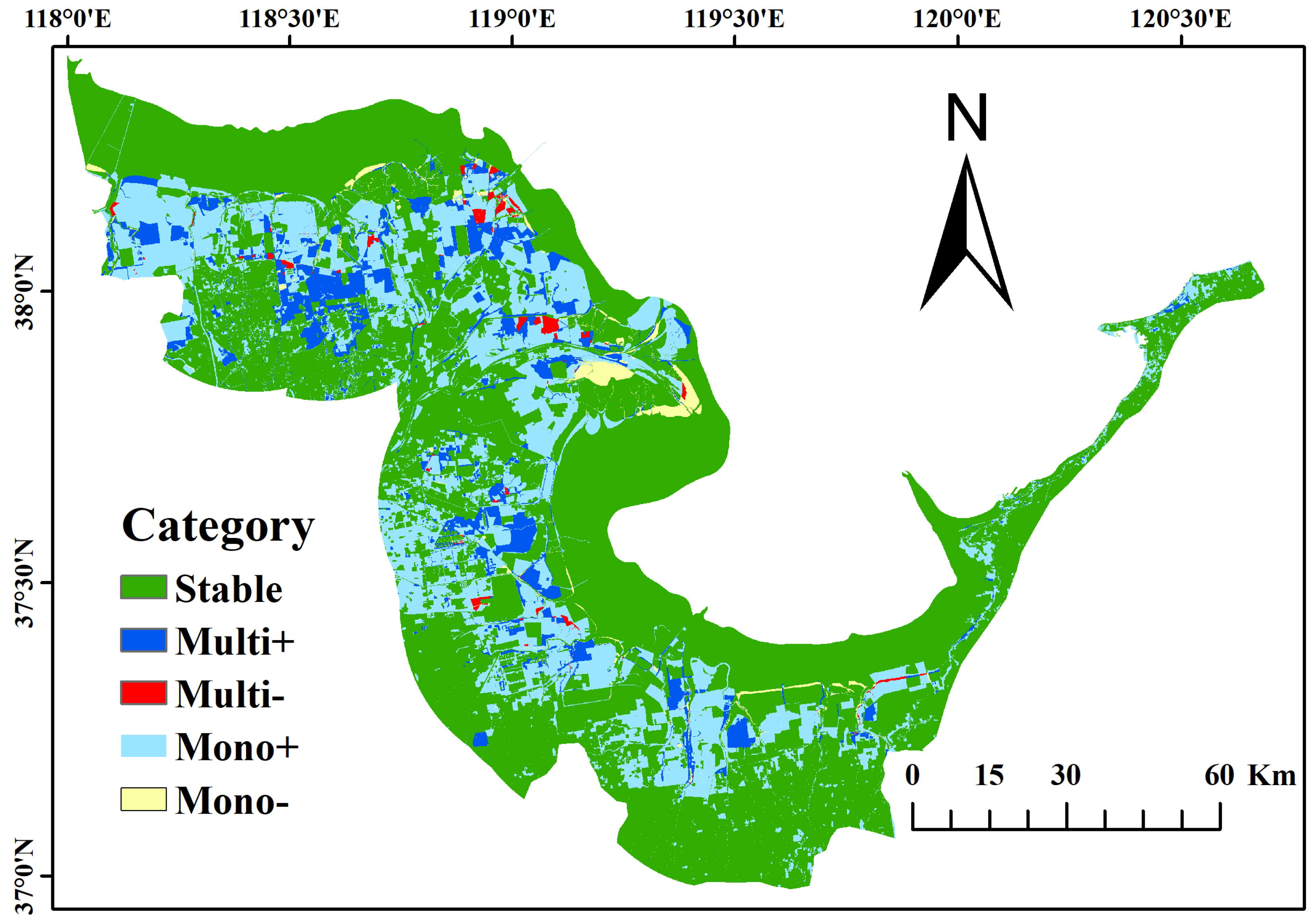
| Code | 1 | 2 | 3 | 4 | 5 | 6 | 7 | 8 |
|---|---|---|---|---|---|---|---|---|
| LULC types | Water body | Tidal flat | Coastal marsh | Mariculture | Salt pan | Built-up area | Shrub & Forest | Cultivated land |
| Driving Process | Accretion (A) | Restoration (Re) | Succession (S) | Reclamation (Rc) | Erosion (E) | Regressive Succession (Rs) | Replace (Rp) |
|---|---|---|---|---|---|---|---|
| Initial-final LULC types | 1–2, 1–3, 1–7 | (4, 5, 6, 8)-1, (4, 5, 6, 8)-2, (4, 5, 6, 8)-3, (4, 5, 6, 8)-7 | 2–3, 2–7, 3–7 | (1, 2, 3, 7)-4, (1, 2, 3, 7)-5, (1, 2, 3, 7)-6, (1, 2, 3, 7)-8 | 2–1, 3–1, 7–1 | 3–2 | (4, 5, 6)-8, (4, 5, 8)-6, (4, 6, 8)-5, (5, 6, 8)-4 |
| 2015 | Built-Up Area | Coastal Marsh | Cultivated Land | Mariculture | Salt Span | Shrub& Forestry | Tidal Flat | Water Body | Type Conversion | |
|---|---|---|---|---|---|---|---|---|---|---|
| 2000 | ||||||||||
| Built-up area | 66.52 | 1.32 | 14.54 | 2.35 | 4.85 | 8.96 | 0.15 | 1.32 | 33.48 | |
| Coastal marsh | 4.97 | 15.12 | 19.65 | 23.76 | 16.63 | 6.05 | 7.13 | 6.7 | 84.88 | |
| Cultivated land | 6.32 | 1.07 | 77.44 | 7.56 | 2.76 | 2.66 | 0.17 | 2.02 | 22.56 | |
| Mariculture | 9.89 | 0 | 10.53 | 41.98 | 32.74 | 0.32 | 2.27 | 2.27 | 58.02 | |
| Salt span | 13.92 | 0.28 | 9.23 | 6.68 | 66.76 | 0.14 | 1.99 | 0.99 | 33.24 | |
| Shrub& Forestry | 6.63 | 7.18 | 23.76 | 20.17 | 13.81 | 22.65 | 2.21 | 3.59 | 77.35 | |
| Tidal flat | 2.97 | 2.54 | 0.85 | 22.97 | 11.73 | 1.84 | 47 | 10.11 | 53 | |
| Water body | 1.74 | 0.49 | 1.06 | 3.28 | 0.6 | 0.16 | 4.78 | 87.9 | 12.1 | |
| Types | Human-Induced | Natural | Human-Natural Coupling |
|---|---|---|---|
| Driving process | Rp-Re, Rc-Rp, Rc, Re Rc-Re, Rp, Re-Rc | A-Rs, Rs-S, Rs-E, A-S S-Rs, A-E, E-A, Rs, E A, S | Re-Rs, E-Rc, A-Rc, S-Rc Re-E, Rs-Rc, Re-A, Re-S |
Disclaimer/Publisher’s Note: The statements, opinions and data contained in all publications are solely those of the individual author(s) and contributor(s) and not of MDPI and/or the editor(s). MDPI and/or the editor(s) disclaim responsibility for any injury to people or property resulting from any ideas, methods, instructions or products referred to in the content. |
© 2023 by the authors. Licensee MDPI, Basel, Switzerland. This article is an open access article distributed under the terms and conditions of the Creative Commons Attribution (CC BY) license (https://creativecommons.org/licenses/by/4.0/).
Share and Cite
Wu, W.; Zhang, J.; Bai, Y.; Zhang, S.; Yang, S.; Henchiri, M.; Seka, A.M.; Nanzad, L. Aboveground Biomass Dynamics of a Coastal Wetland Ecosystem Driven by Land Use/Land Cover Transformation. Remote Sens. 2023, 15, 3966. https://doi.org/10.3390/rs15163966
Wu W, Zhang J, Bai Y, Zhang S, Yang S, Henchiri M, Seka AM, Nanzad L. Aboveground Biomass Dynamics of a Coastal Wetland Ecosystem Driven by Land Use/Land Cover Transformation. Remote Sensing. 2023; 15(16):3966. https://doi.org/10.3390/rs15163966
Chicago/Turabian StyleWu, Wenli, Jiahua Zhang, Yun Bai, Sha Zhang, Shanshan Yang, Malak Henchiri, Ayalkibet Mekonnen Seka, and Lkhagvadorj Nanzad. 2023. "Aboveground Biomass Dynamics of a Coastal Wetland Ecosystem Driven by Land Use/Land Cover Transformation" Remote Sensing 15, no. 16: 3966. https://doi.org/10.3390/rs15163966







